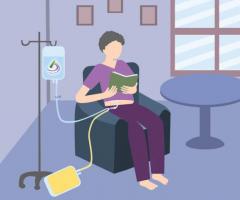Peritoneal Dialysis (PD) is a treatment that uses your peritoneum, a membrane lining your abdominal cavity, as a filter to remove wastes from your body. This type of dialysis requires the assistance of a care provider.
Your peritoneum performs a job similar to the dialyzer in a dialysis machine during treatment or that of your kidneys every day. Waste products and excess fluid in the blood pass through the peritoneal membrane and combine with dialysate (dialysis fluid) in the abdominal cavity, which is then drained along with the waste product diffused from the blood. The peritoneum separates your blood from the dialysis fluid and allows this diffusion process to take place. An exchange occurs whenever fluid i...
Peritoneal Dialysis (PD) is a treatment that uses your peritoneum, a membrane lining your abdominal cavity, as a filter to remove wastes from your body. This type of dialysis requires the assistance of a care provider.
Your peritoneum performs a job similar to the dialyzer in a dialysis machine during treatment or that of your kidneys every day. Waste products and excess fluid in the blood pass through the peritoneal membrane and combine with dialysate (dialysis fluid) in the abdominal cavity, which is then drained along with the waste product diffused from the blood. The peritoneum separates your blood from the dialysis fluid and allows this diffusion process to take place. An exchange occurs whenever fluid is added to the abdomen. Thus extra fluid and wastes are drained along with the fluid.
Peritoneal dialysis is carried out through a dialysis catheter placed in the abdomen, where you exchange the old solution for a new solution.
An exchange has 3 steps: STEP 1: Drain
The PD catheter is connected to a drain bag, and the used and saturated solution inside the abdomen is drained. This solution contains waste as well as excess fluid.
STEP 2: Fill
After the old solution has been completely removed from the abdomen, a new dialysis solution is poured in through the catheter to fill the peritoneal cavity, which is located in the abdomen.
STEP 3: Dwell
The dialysis tubing and bags are removed once the new solution has been placed. You can do your normal activities while wearing only a short tubing set covered by a sterile cap. During this time, the dialysis solution remains in the peritoneal cavity. This is the time when dialysis takes place, and the solution collects waste and excess fluid from your body.



